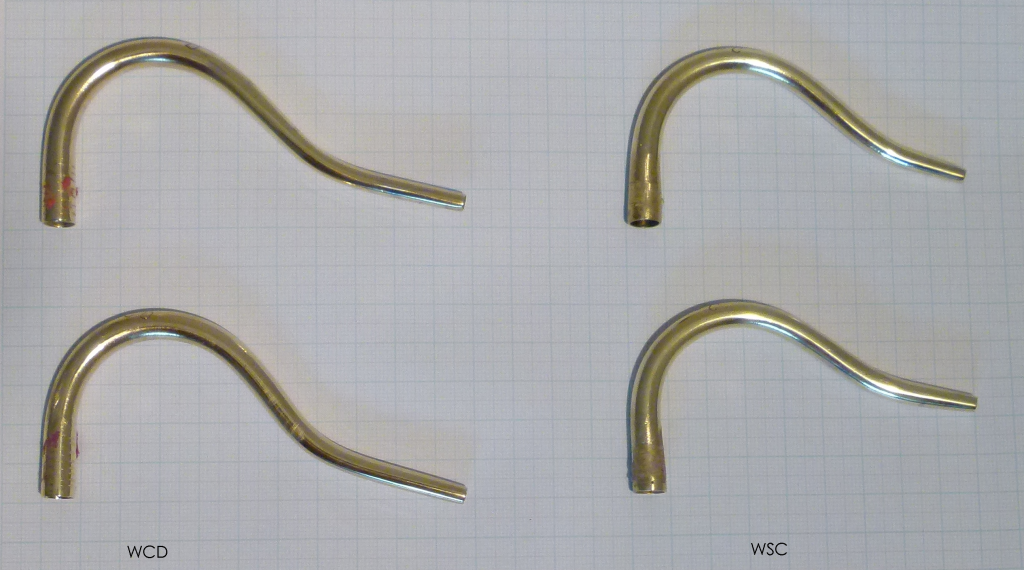Bocal comparisons
Six surviving fagottino bocals belonging to the following instruments were considered in an initial comparison: FT14 Denner, FT29 Scherer (2), FT20 Müller, FT13 Delusse, FT25 Savary (2) and FT12 Castlas. See Graph 1, Comparison of six fagottino bocals – internal ø.
Measuring methods
Measurements were taken from small to large bocal ends at increments of 2.5 mm for the first 20 mm and at increments of 5 mm for the remaining length using digital calipers. Bocal length was measured along the top, with zero being at the small end; accordingly, each increment was measured and noted.
Two external diameter measurements were taken in perpendicular cross sections at each increment: external diameter B from side to side, and external diameter A from top to bottom side. The inner diameters were calcaluted by subtracting the double of the evaluated brass thickness for that bocal region from the external median diameter at each increment.
The “general brass thickness” was calculated by subtracting the median internal diameter from the median external diameter at the bocal’s large end at that point (always measured with digital calipers), and divided by two. This general brass thickness was also compared with the thickness detected by digital calipers. Using the same procedures, thickness was measured at the bocal’s small end; this value was considered the “smallest general thickness”.
In order to take into account the change of thickness from small to large ends, the bocal was divided into two regions: the first region being 20 mm long from the small end (from where the brass gets progressively thicker); the second region starting after 20 mm (here the brass thickness is considered constant and corresponds to the calculated “general brass thickness”). In the first region, the median internal diameter at zero (that is, the real beginning of the small end) was calculated by subtracting the double of the “smallest general thickness” from the median external diameter at zero; this is an important reference value.
When the first region was visibly cylindrical and supported in mathematical and graphical senses with no big steps in values,the double of the “smallest general thickness” could be subtracted from the first median external diameter to determine the internal diameter; when this was not possible, also for all values after zero and before 20 mm, a graphical approximation was then made between the internal median diameter at point zero and the internal median diameter at the increment of 20 mm. This could be done manually by drawing a possible diameter progression line from the known value at zero to the value at the increment of 20 mm, or automatically, using graphics software.
Conclusion
The two models we ultimately chose to reproduce represent differing concepts of trends in profile:
a) FT 29 Scherer bocal is unique in comparison to the others, and has a strong exponential increase of internal diameter in the first 20 mm: 3.5 to 5.25 mm, before reaching a slower growth; b) FT 13 Delusse bocal is similar to all of the others, with a more regular diameter profile, and was also chosen because of its good condition and date. See Graph 2, Comparison of FT29 and FT13. Furthermore, FT29 is 130 mm and FT13 is 153 mm long.
The other bocals considered (FT25 Savary and FT12 Castlas) belong to later instrument models, and the FT 20 Müller bocal has considerable damage in its seam solder, making a truly accurate reconstruction and comparison difficult.
Graph 3, Comparison of FT13 and FT 20 illustrates that the diameter profile of FT13 Delusse bocal is very similar to that of FT20 Müller, although shorter in length.
